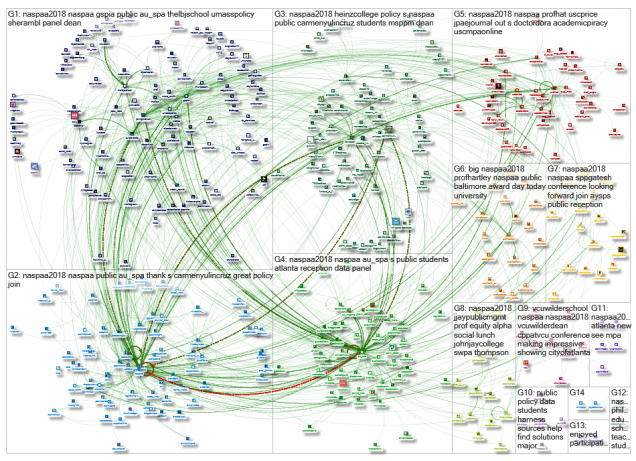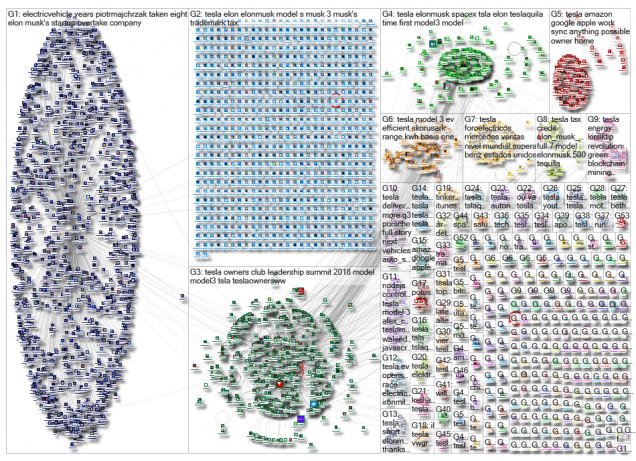The first graph shows a typical unified network. The tight crowd mainly consists of 5 medium groups. This is a network of 403 Twitter users whose recent tweets contained “#NASPAA2018”, or who were replied to or mentioned in those tweets. NASPAA stands for Network of Schools of Public Policy, Affairs, and Administration, which is a Washington, D.C.-based non-profit organization. It is an international association of public affairs schools (schools of public policy and administration) at universities in the United States and abroad (Wikipedia, “NASPAA”, n.d.). The “#NASPAA2018” hashtag is used by people who organized or participated in the 2018 NASPAA Annual Conference, which has the theme “Making a Difference: Good Governance in Disrupted State(s)”. The conference features dynamic keynotes, workshops, and panels with over 350 unique speakers from over 160 schools.

As Himelboim and his colleagues pointed out, the discussions of a tight crowd are characterized by highly interconnected people with few isolated participants, I think what the graph shows just accords with that. The most influential user here is @AU_SPA, which is an account held by American University’s School of Public Affairs. Other top influencers include @carmenyulincruz, who is the mayor of San Juan City and has given a speech at the conference. The top URL in the entire graph is a tweet of @naspaa – “The 2018 Class of NASPAA Next are super engaged and enjoying the first day of #NASPAA2018.” All the top influencers and the central users of each group have strong connections to each other as they are either schools of public affairs of different universities or professors and experts in the field of public affairs. The most retweeted tweets are all related with the process of the conference and the speakers’ inspiring talks.

The graph above is the network map of tweets using the hashtag #tesla between October 11 and October 14, 2018. I personally think the map shows a combination of 3 kinds of network crowds, which are brand clusters, community clusters and broadcast network.
According to Himelboim et al., brand clusters is formed around products and celebrities, and here the topic is about the popular electric car brand Tesla. As can be seen from Group 2 in the graph, the topic of tesla attracts large but fragmented Twitter users, and there is little connectivity. Tweets in this group all mention tesla but they focus on different aspects and thus don’t have any connection to other tweets. For example, one tweet says, “The new interface for air flow is amazing”, while another says, “Waiting in the car while wife shops just gets easier”.
Except from the brand clusters, the graph also demonstrates the features of community clusters. Group 3, 4 and 5 are medium sized groups, and users in these groups are densely connected to each other rather than mostly unconnected. The three groups share the main topic but each has a different focus about tesla. Most of the users in Group 3 tend to mention @Tesla and use the hashtags #Tesla Owners Club 2018 Leadership Summit and #Tesla Model3; the users in Group 4 mention the CEO @elonmusk and congratulate him on surpassing the sales of Mercedes-Benz; users in Group 5 all retweet the tweet “When #Amazon, #Google, #Apple and #Tesla work in sync anything is possible.” So, just as Himelboim and others said, the community clusters are like conversational bazaars, where interests vary from stall to stall.
The group on the left side shows the feature of broadcast network. In the center of Group 1 is @piotrmajchrzak whose tweet “It’s taken just eight years for Elon Musk’s #ElectricVehicle startup to overtake the company that invented the concept of the car 132 years ago. #tesla” with a news link “Tesla just outsold Mercedes-Benz in the US for the first time” is retweeted by more than 3000 users. This just accords with how Himelboim and others define broadcast network – The Broadcast Network structure is dominated by a hub and spoke structure, surrounded by spokes of people who repeat the messages generated by the news organization or personality. However, the central user here just has about 500 followers, so he is definitely not a news pundit. The large amounts of retweets he gets may be explained by the point made by Lee Rainie. According to Rainie, in the age of the Triple Revolution, anyone with an internet connection and a bit of digital literacy can create online content that has the potential to reach a wide audience. In addition, the boundaries between producers and consumers are becoming blurred in the network operating system, which enables noncredentialled amateurs to participate in many of the arenas that were once limited to recognized and sanctioned experts (Rainie & Wellman, 2012).
To sum up, graph 1 shows how networked learning communities function and how sharing and mutual support can be facilitated by social media, and graph 2 demonstrates how a single social media topic can reflect diverse angles on a subject and reveal a diversity of opinion and perspective. Both graphs show the potential of utilizing different types of social networks to control infomediation. According to Smyrnaios, one of the characteristics of infomediation is that it is a means for selecting and prioritizing information that involves algorithms and mediated social interactions to varying degrees (Smyrnaios, 2018). Based on the different characteristics of six network types, the process of selecting and prioritizing information can be more focused and effective.
References
Network of Schools of Public Policy, Affairs, and Administration. (n.d.). In Wikipedia. Retrieved October 14, 2018, from https://en.wikipedia.org/wiki/NASPAA
Rainie, Lee., Wellman, Barry. (2012). Networked: The New Social Operating System. The MIT Press. Cambridge, Massachusetts.
Smyrnaios, N. (2018). Internet oligopoly : The corporate takeover of our digital world (Digital activism and society). United Kingdom: Emerald Publishing.